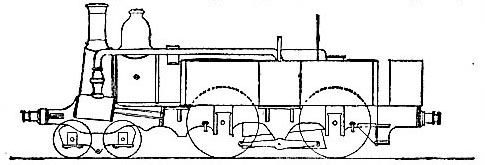1902 Encyclopedia > Railway, Railways (Railroad) > Locomotive Power: Other Locomotives; Rates of Speed.
Railway, Railways
(Part 32)
F. LOCOMOTIVE POWER
Other Locomotives; Rates of Speed.
Other Locomotives
Four-coupled locomotives, having the cylinders inside, and four wheels coupled "in front," with a pair of hind or trailing wheels, are known as "mixed engines,"—that is to say, engines adapted for either passenger traffic or goods traffic,—a generally useful type. In one example the cylinders are 16 inches in diameter, with a stroke of 22 inches; the coupled wheels are 5 feet in diameter. The weight of the engine is 24 1/2 tons, of which 20 tons are driving weight.
The next engine to be noticed is a generally useful engine, four-coupled "behind," for passenger traffic, such, for instance, as that with inclined fire-grate and sloping fire-box designed by Mr. J. J. Cudworth for service on the South-Eastern Railway. On a wheelbase of 15 feet the weight of the engine—30 1/2 tons—is so distributed that 10 1/2 tons fall at each pair of driving-wheels and 9 1/2 tons at the leading wheels. The cylinders are inside, 16 inches in diameter, with 24 inches of stroke and 6-feet driving wheels.
Another express passenger locomotive, having inside cylinders and four-coupled wheels behind, for service on the London and North-Western Railway, has cylinders 17 inches in diameter, with 24 inches of stroke, and 6 feet 7 inch driving wheels. The engine weighs 29 1/4 tons, of which 11 are at the middle wheels, 8 3/4 at the hind wheels, and 9 1/2 at the front; thus the driving weight amounts to two-thirds of the total weight. This engine can move a gross weight of 293 tons, comprising engine, tender, and train, on a level at a speed of 45 miles per hour, with a working pressure of 120 lb per square inch in the boiler. With trains averaging ten carriages the consumption of coal is 26 1/4 lb per mile run.
A tank locomotive is an engine which carries its supply of fuel and water with it on its own frame, dispensing with the tender. Such engines are much used for short traffic, as well as for shunting and marshalling trains.

Fig. 41. Tank locomotive: Metropolitan Railway.
The four-coupled tank engine (fig. 41) used for the passenger traffic of the Metropolitan Railway has four wheels coupled behind and a bogie in front. This engine weighs in working order 45 1/4 tons, of which about 35 tons are utilized as driving weight, making 17 1/2 tons for one pair of wheels,—about the greatest load on one pair of wheels anywhere. The regular duty of this engine is to take a train of six carriages capable of holding in all 432 passengers, and weighing in themselves 13 tons each, at an average speed, including stoppages, of 18 miles per hour, consuming 37 lb of Welsh coal per train mile run. Whilst passing through the tunnels or covered ways the exhaust steam from the engine is condensed in large tanks carried on the engine, filled with cold water. The quantity of condensing water consumed is 900 gallons for half the journey, or every 6 1/2 miles; it is raised to 200° Fahr. temperature.

Fig. 42. Tank locomotive: Great Eastern Railway.
The eight-wheeled tank engine (fig. 42) has been designed by Mr. T. W. Worsdell to work the heavy suburban metropolitan traffic of the Great Eastern Railway,—the ordinary trains in this service being composed of fifteen or twenty close-coupled carriages, taken over steep gradients and sharp curves. For this purpose the fore and hind axles are radially mounted, as before explained, to take the curves with facility, the engine running either end first. The engine weighs 52 tons in working order, and of these 30 tons are driving weight placed on the two pairs of coupled driving-wheels. With large cylinders 18 inches in diameter, and driving-wheels only 5 feet 4 inches in diameter, the engine is adapted for starting promptly, which it is required to do in order to keep time between closely placed stations. Every stop is made by the Westinghouse brake, with which the engine is fitted.

Fig. 43. The Fairlie locomotive.
Locomotives for drawing heavy goods trains, though not heavier than the most powerful passenger locomotives, can take goods trains of great weight. Six-coupled goods engines, with 17-inch cylinders and driving-wheels 5 feet in diameter, weighing 32 tons in working order, can take a train weighing 360 tons on a level at a speed of 25 miles per hour, consuming from 40 to 45 lb of coal per mile run with trains. The Fairlie engine (fig. 43) is placed on two bogies or swivelling trucks, the foremost of which carries the cylinders and propelling gear and the hindmost the tank and coal-boxes.
Rates of Speed
The longest distance run without stopping, combined with the highest speed, is performed on the Great Northern Railway, between Grantham and King’s Cross, 105 1/4 miles, in 1 hour 58 minutes, at the rate of 53 1/2 miles per hour. The Great Western Company run from Paddington to Swindon—77 1/4 miles—in 1 hour 27 minutes, being at the rate of 53 1/4 miles per hour. On the London and North Western Railway the distance—77 1/4 miles—from Willesden to Rugby is run in 1 hour 28 minutes, at the rate of 52 3/4 miles per hour. The average rate of express and mail passenger trains on this line is 40 miles per hour or more. Parliamentary trains, calling at all stations, run at an average speed of from 19 to 28 miles per hour. Express goods trains attain a speed of from 20 to 25 miles per hour. The speed of coal trains is limited, as far as possible, to 15 miles per hour.
Read the rest of this article:
Railway, Railways - Table of Contents
|


